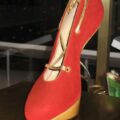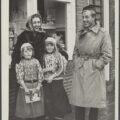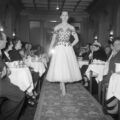Edith Head – Silver screen designer
January 21, 2017Edith Head was one of Hollywood’s Golden Age’s most celebrated costume designers. She made the style of the costumes from the films she worked on iconic and in demand right across the fashion world – from the sarong she costumed Dorothy Lamour in for Dottie’s very first credited film, Jungle Princess of 1936, which spawned many holiday sarong clad beach princesses all over Europe and America, to working with Mae West on Mae’s first big film too (She Done Him Wrong, 1933) – and who doesn’t want Mae’s style?
Hollywood Costume designer
Picture a stern looking woman with a severe bob and matching fringe, ebony black hair that’s cut into perfect shape, with not a single hair out-of-place. A pair of glasses that adds to the seriousness of her face, and you could have a teacher, a governess, or a piano teacher staring back at you.
But you’d be wrong, for this was Edith Head, one of the most successful costume designers in Hollywood and the only woman to have been nominated for a staggering 35 Oscars. She won 8 out of those 35 and she deserved every single one.
Early beginnings
Edith Head got a job working at Paramount at 18 working as a costume sketch artist, and from here she would work her way up to Head of Department, a rarity for a woman, at this time in Hollywood.As well as designing costumes, Head also created outfits to be worn for award ceremonies which created every bit as much envy and adulation as her film costumes did.In 1938 Edith Head was rewarded for her hard work when she was made head of the design department with the title Head of Costume. This was a rare achievement for a women in Hollywood, but Head had worked hard for this and well deserved the promotion.
Award Ceremonies
Grace Kelly’s dress worn to the 1954 Oscars cost $4,000, which was unheard of back then, but was a great success. Hepburn’s dress for Roman Holiday, designed by Edith Head, was adapted for the ceremony by Hepburn’s own favourite designer Hubert De Givenchy.
Hitchcock and Head
Alfred Hitchcock the auteur of cinema, was at the height of his fame when Edith Head worked with him, and she would provide costumes for 11 of his films over the period they worked together. Hitchcock’s blondes never looked so mysterious and provocative than when Head had dressed them.
Elizabeth Taylor and that dress
One dress designed by Edith Head would create the greatest stir, and that was the chiffon dress designed for Elizabeth Taylor for the film A Place in the Sun. The dress came with straps, chiffon and a wide skirt. It would be so popular with audiences that it would be copied several times by designers all over the world and in America, it became the staple prom dress for high schools all over the country. Unsurprisingly she won an Oscar for this film.
Final Oscar for The Sting
Edith Head’s final Oscar would be for The Sting in 1974 which would star Robert Redford and Paul Newman. Following her success at Paramount, Head went to work with Universal and stayed there until her death in 1981, dressing for TV as well as for film. She designed a breath-taking 444 costumes during her career, between the mid-twenties and up until the early eighties.
Look at any film from the 40s and 50s and see if you can spot her name in the credits, you may already have recognized the name, but not realized, or cared who she was. With this blog in mind, keep an eye out for her name now, and just think about the amazing contribution she made to film.
Edith Head famous at 83
Edith Head was born in California in 1897. She died still famous at the age of eighty-three in 1981, having completed her last film only weeks before, an Eighties parody of the Forties film noir period that was her heyday entitled Dead Men Don’t Wear Plaid, starring Steve Martin whom she dressed in a version of the slinky outfits she had first put Barbara Stanwyck in for Double Indemnity in 1944.
She was never trained as a designer, but rather first became a school teacher, teaching French and art to private school girls. Edith actually enrolled in night school to get ideas for the art lessons she would pass on to the pupils, preferring landscapes as she confided in a friend that she didn’t know how to draw the human figure.
Edith Head – A Seascape Artist
But school teachers at that time were not paid during the long summer holidays, and needing extra money she applied for a job she saw in a newspaper for a sketch artist at Famous Players-Lasky (later to become Paramount Studios). For the portfolio she took along to the interview, she borrowed night school friends work, “I was studying seascape and all I could draw was oceans… I asked everybody in the class for a few costume design sketches. And I had the most fantastic assortment you’ve ever seen in your life. When you get a class of forty to give you sketches, you get a nice selection. It never occurred to me that it was quite dishonest. And all the students thought it was fun, too, just like a dare to see if I could get the job.”
Edith Head – A Start as a Sketch Artist
She did get the job to become one of a pool of twelve sketch artists, working under design head Howard Greer. But whatever her initial skills lacked, she must have caught up quickly, because “At first I just sat in the room with the other sketch artists and sketched. I never got down to the set to see the clothes. I never met the stars, but gradually this changed. Greer would bring me a little croquis, a thumbnail sized pencil sketch of a design, which I would enlarge in colour for him. Then sometimes he would take me out into the workroom to see him drape model figures with the garments made from these designs. It was like watching the drawings come to life.”
The Very Awkward Elephant
Travis Banton, another major name in Hollywood costume design, joined Howard Greer as a top designer at Paramount and soon she was assisting the two men. She was absolutely thrilled when she was given her very own scene to design – a dance extravaganza in a Cecil B DeMille film, The Golden Bed (1925). The script called for life-sized candy and chocolate bar men, and Head decided to add a lifelike touch by using real sweets and chocolates. They melted into a huge gooey mess under the hot lights, of course, to Head’s extreme embarrassment.
Her next big moment was just as bad – she decorated an elephant on another DeMille film, The Wanderer (1926). She lovingly draped him with garlands of fruit and flowers, which the delighted animal wouldn’t stop eating. Eventually she solved the problem by using artificial ones, but not until the comedic scene had gone down in history.
In between these moments, Edith worked on minor films and Westerns, which she called “Horse Operas”, and started to dress all the supporting actors in Travis’s big films, whilst Travis himself dressed the star.
Edith Head – An It Girl
Travis Banton was now the head designer at Paramount, and was famous for how alluring he made his leading ladies look. His stars demanded to be dressed by him personally and if any of them were relegated to a design assistant they were hugely offended. However, this is just what happened to Clara Bow. Travis reportedly didn’t like working with Clara, as her figure – rather short with hourglass curves – didn’t fit the style of dresses he wanted to make.
Eventually, one day he passed her to Edith Head to dress for the film Wings (1927) This was Head’s first big star – Clara Bow, the original It Girl was a major draw at the box office. Unfortunately the script called for Clara to be dressed throughout the film in a deeply unflattering, boxy nurse’s uniform for the US Army Airforce. Uniforms of the United States Army had to be completely true to life on film, so Edith couldn’t alter the costume. Clara kept grabbing a belt to cinch the outfit in at the waist, and Edith kept taking it off her.
Despite this, the pair became friends. Clara and Edith went for rides together in Clara’s red convertible, chosen to match the star’s flaming hair, with Clara’s two small dogs, who were also dyed red.
A Fantasy World
Although the costume for her first star, Clara Bow, had to be strictly accurate to comply with US Army regulations, the opposite was the case for most of Edith Head ‘s output in Hollywood. Edith remembers dressing Barbara Stanwyck as a doctor character for Internes Can’t Take Money (1937) in a white satin uniform and pumps. The audience didn’t mind, she says, as they wanted to escape their every day lives in Depression hit America. “It very typical of the 1930s. Imagine, an intern wearing tight white satin! At the time, that’s what audiences wanted –escapist drama. So we gave it to them.”
Tightening the Hollywood Belt
When the USA joined the Second World War, however, even Hollywood had to tighten its belt. It had always been the practice that dresses used for the leading lady in one film were re-used for a background character in another, but now a campaign of re-dying, neckline altering, re-trimming and generally altering and e-using dresses and costumes began in earnest. The austerity campaign was not done on the quiet but publicised to set an example to the public. Edith complied whilst managing to make her stars as glamorous as ever. Dressing Dorothy Lamour for Road to Morocco in 1941 was her first challenge. “I made ever possible concession. When I wanted her to wear silk pantaloons, I substituted sheer cotton. When I wanted gold metallic trim, we used kidskin and painted it gold. It all worked, thanks to some ingenuity and clever lighting effects.”
The Teeth
As Edith Head became friends with more and more Hollywood stars, due to her hard work, dedication to the job, keen design flair but above all her talent for listening to what her clients wanted and dressing them to their best advantage, she was naturally invited out with them and to swanky Hollywood parties too.
But although the costume designer was slim and striking looking, she was very small, at only 5’1”, wore extremely thick glasses, but more than that, she had been teased since childhood for her strange teeth. Two of her top incisors never grew, and due to the defect she was self-conscious and rarely smiled in photos – in fact she rarely agreed to photos by the studio Her teeth were not fixed until Barbara Stanwyck dragged her off to her own dentist, a miracle worker who was able to help where other dentists had failed. By then Edith was forty.
A Costume Designer with Flair
But Edith knew that to become a big name in Hollywood, she needed to have a big personality, unhampered by shyness. She saw how the other big costume designers of the day, Adrian (Adrian Adolf Greenberg) and Erte (Romain de Tirtoff) were feted in the gossip columns. She didn’t let her early self-consciousness hold her back, and made her glasses into part of her look, and started dressing with impact. Photographs still did not show her smiling, but she began to appear as part of Paramount Picture’s publicity photographs as a celebrity in her own right.
Edith Head – Head Designer at Paramount
By now, Edith Head had replaced Travis Banton as head designer. Some said that she planned to oust him, but she maintained that she had been absolutely loyal to him and often covered for him during both planned and unplanned absences. Rumour was that he drank too much and as his drinking got out of hand he became unreliable. In any case Travis left to become a freelance designer instead and Edith stepped into his shoes with little fanfare. She had always studied his work carefully and strongly credited him with helping her to become a great designer.
Edith was ambitious, and though she worked hard for her stars, spending hours consulting with them, she expected her assistants to work hard in turn for her. She was known as a hard task master, and often had arguments with those underneath her.
Edith Head – A Catholic in Tinseltown
In her private life, Edith was a Catholic and therefore disapproved somewhat of the wild lives that some of the starlets lead. It also made it difficult for her to divorce her husband, Charles Head. They had married young, and as a travelling salesman whilst Edith was first a teacher then a designer, the pair did not spend much time together. Charles was also an alcoholic, and did not much like Hollywood parties. The pair therefore had little in common, and did eventually divorce, in 1938 when Edith was 41, although Edith kept his surname throughout his life and stayed in touch with him. She was at his side when he died.
In 1940 Edith Head remarried a man called Wiard Boppo Ihnen, who was known as Bill. He was a highly regarded art director at Paramount, and the pair had been good friends for years, having discussions long into the night about art, philosophy, clothes, studio gossip and Bill’s love of Mexico.
Hollywood vs Paris
Hollywood began a campaign to deliberately eclipse Paris as the epicentre of fashion, as studio heads had found that by the time films came out fashion had moved on – therefore, they wanted to be the ones who dictated style. The idea worked and movie and fan magazines breathlessly began to report on movie star styles that every woman should be wearing, how to get your hair just like Betty Grable’s and your eyelashes like Bette Davis.
As an extension of this Edith Head, as Paramount’s top designer, became a brand name in her own right, endorsing products like children’s dresses and man-made fibres, and completing one or two ready to wear collections for department stores, which did not sell enough for them to do Edith Head collections on a regular basis. She appeared on TV and radio, and wrote for magazines, giving advice on how the average woman could look her best. She also wrote two books, The Dress Doctor (1959) and How To Dress For Success (1967). Later in life she also brought out a series of Vogue patterns.
Every Hollywood Star
Overall, Edith Head ’s list of stars couldn’t be brighter: she dressed just about every Hollywood star you could name, including Grace Kelly, Audrey Hepburn, Elizabeth Taylor, Goria Swanson, Paulette Goddard, Olivia de Havilland, Joan Blondell, Veronica Lake, Mary Martin, Loretta Young, Ginger Rogers, and Ingrid Bergman. She also dressed male stars, like Bob Hope, Gregory Peck and David Niven. Although she was contracted to Paramount Pictures for most of her career, stars often requested that she dress them when they were featuring in films by other studio, so she was lent out and her credit appeared in pictures all over Tinseltown. In 1967, when Edith was 70, she left Paramount and joined Universal Pictures.
Edith Head – Personal designer to the stars
Edith often designed not only a star’s on screen clothing but her personal wardrobe too, partly because the studios made sure that the actress’s image was in keeping with what they wanted to project about her. This could include wedding dresses and gowns to host Oscar ceremonies.
There was no Oscar for costume design when she started in the business, but by the time she died Edith Head had been given thirty-five Academy Award nominations, and won eight. She also has a star on the Hollywood Walk of Fame on Hollywood Boulevard.












